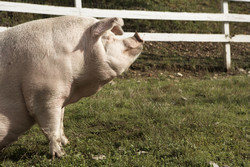Tackling porcine viruses
PRRSV has considerable genetic variability with emergence of highly pathogenic strains causing extensive pig mortality. It causes reproductive and respiratory problems in pigs and is also undermining the pig's immunity, leading to extensive bacterial infections. Existing vaccines are unable to control all PRRSV strains and widespread use of antibiotics only exacerbates drug resistance incidence. Seeking to address these issues, the EU funded PORRSCON(opens in new window) (New tools and approaches to control porcine reproductive and respiratory syndrome (PRRS) in the EU and Asia), a collaboration between Europe and Asia set out to develop new tools and approaches to control PRRS. In this context they created a public virus bank that included European, Asian and American isolates encompassing both virus genotypes. Partners sequenced and characterised a number of PRRSV strains with different genotypes and subtypes. For diagnosis, the majority of available PRRSV kits were validated using particular virus subtypes most common in Europe. However, these kits may not be as sensitive for detecting other virus subtypes, emphasising the need for continuously monitoring PRRSV genetic diversity and evaluating diagnostic tests. Ultimately, results revealed that a combination of techniques including serological analysis could prove to be more effective for PRRSV detection. A currently available vaccine generated against subtype 1 was found to offer partial protection against the highly pathogenic PRRSV subtypes of Eastern Europe. Significant effort was devoted to the development of new vaccines capable of boosting PRRSV-specific humoral immunity and reducing virus load in piglets. To further facilitate the design of novel vaccines, scientists performed virulence analysis and identified two implicated genes, which could be targeted to attenuate the virus. In addition, they investigated the pathogenesis of congenital infection and measures that could prevent infection of foetuses. To this end, they found one attenuated vaccine capable of protecting piglets against lethal challenge. Overall, the activities of the PORRSCON project have alerted authorities about PRRSV transmission through international animal trade. The generated tools and vaccines are anticipated to control virus spread and minimise its detrimental consequences.







